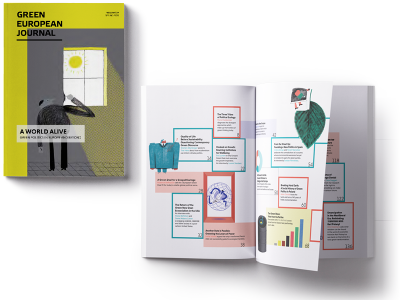The 2019 European elections saw Green parties achieve their best ever result. Their new weight in a fractured European Parliament is an opportunity for progress on climate, democracy and the rule of law, and social justice. Green parties often perform better at European elections but this time the success is sustained elsewhere. Local elections in the UK, national elections in Portugal, government coalitions in Finland, Sweden, and Luxembourg – the Greens are advancing at all levels. The major caveat is that the “green wave” is absent from much of southern and eastern Europe. Part of our latest edition looks at where political ecology made electoral gains, bringing together analyses of five Green parties to see where they are and to assess their prospects for the years to come. In Ireland, major advances at the European elections in 2019 were carried through to a strong general election result in early 2020. With government negotiations still up in the air, Dan Boyle explains how the Irish Greens bounced back.
After the elections in February 2020, three parties are near identical in their parliamentary numbers. Comhaontas Glas (the Green Party) is now the fourth largest party. The biggest winners were left-wing Sinn Féin. The most likely scenario is a government with a Fianna Fáil (most seats) — Sinn Féin (most votes) nexus. Though it could depend on independents, a third party would give the coalition greater stability and the Greens will be first approached. At the time of writing, the outcome is uncertain.

Today seems a long way from March 2011 when, as a member of the Seanad (the upper house), I witnessed a new government elected in the Dáil (the lower house). Some weeks earlier the Greens had left government, precipitating a general election in which the party lost all of its seats. The Greens’ first experience of government coincided with the global downturn of 2008. There would be no Green participation in the following parliament. We had been told that government participation had thrown back environmental politics in Ireland by a generation.

Eamon Ryan made himself available to lead the party back from the wilderness. The party returned to its volunteer roots to reorganise. The commitment of these volunteers, especially a newer, younger cohort, proved crucial to the party’s revitalisation.
The first electoral tests were local and European elections in 2014. The party won an additional 10 seats in local councils, steady if not spectacular. Green parliamentary representation was restored in the general election of 2016, giving the party access to state funding again. With this support, the party began to professionalise in many areas, including the better management of membership databases, improving social media messaging, and engaging in greater outreach, especially outside of Dublin.
Ireland, whose politics had never been that ideological, was becoming more liberal. Public votes on same-sex marriage in 2015 and abortion rights in 2018 saw a new Ireland emerge. This liberalism helped the electorate see the Green Party in a positive light. In the local and European elections of 2019, the party quadrupled local government representation and elected two MEPs.
What the recent successes will mean for the Green political agenda remains to be seen. The main issues on which the election was fought, housing and health, can easily be accommodated between the parties. It is on environmental policy where agreement will be difficult. While Sinn Féin talks approvingly about sustainability, it is committed to infrastructure spending biased towards roads and against public transport and even talks of reducing Ireland’s small carbon tax. A 7 per cent yearly reduction in emissions will be Comhaontas Glas’s priority for any programme for government.
This article is part of our latest edition, “A World Alive: Green Politics in Europe and Beyond”.

